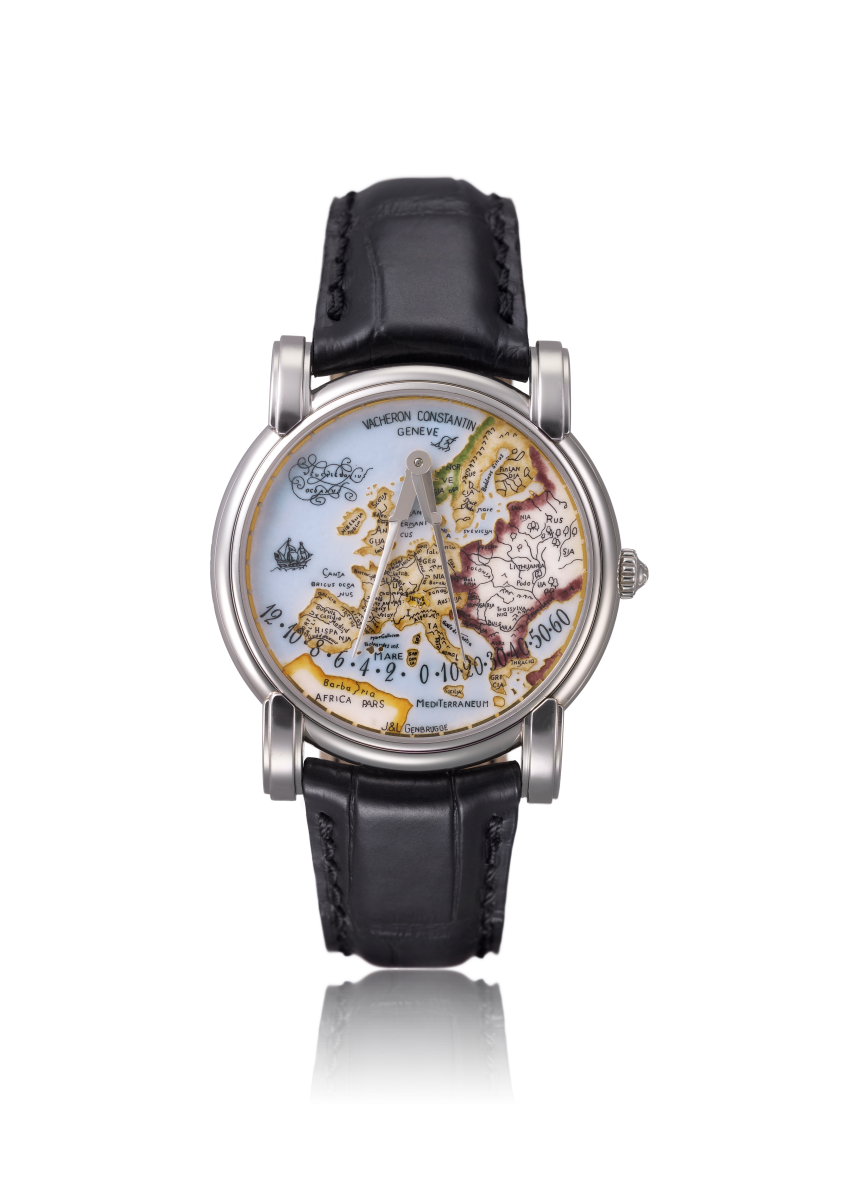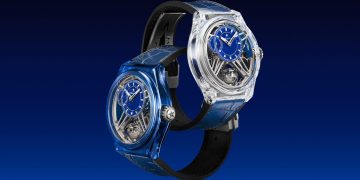Source: Images and content by Vacheron Constantin
http://content.presspage.com/uploads/1999/05521335-3c80-4787-80fa-bc6508beaafa/500_11473-1v401303.png?10000
- Retrograde displays, which appeared in the 18th century and are sometimes accompanied by jumping indications, represent a technical difficulty that calls for extreme precision.
- At Vacheron Constantin, jumping indications appeared in pocket watches as early as 1824, with retrogradedisplay wristwatches following a century later.
- These horological complications have become a Vacheron Constantin signature and are now part of the company’s current collections.
Special displays, which are used in the construction of mechanical watch movements to uncouple the functions indicated on the dial from the going train, were of interest to watchmakers at a very early stage. These complications, which include jumping and retrograde displays, offer the possibility of new technical and aesthetic interpretations of the passing of time. Vacheron Constantin began designing pocket watches with jumping indications from the dawn of the 19th century and developed watches with retrograde displays in the 20th century. These display complications have become a technical and aesthetic signature of the Maison and are featured in several collections.
Retrograde and jumping displays are a technical complication that rapidly caught the attention of watchmakers wishing to go beyond traditional time indications involving a central hour hand and the date shown by a number appearing through an aperture. Historical records contain mentions of these alternative modes in the mid-18th century already, thanks to dial arrangements made possible by displacing certain time or calendar indicators. Vacheron Constantin’s first jumping displays appeared as early as 1824. But it was above all from the mid-1930s onwards that the Maison distinguished itself with retrograde displays on wristwatches, at a time when watchmaking codes were driven by strong creative momentum.
High-precision mechanisms
A display is said to be of the retrograde type when the indicator does not make a complete turn of the dial, but instead returns to its starting point and begins running again after covering its entire measurement segment. This is usually by means of a hand moving across the arc of a circle. In addition to retrograde displays for cyclical time indications such as hours, minutes, seconds or dates, there are also so-called “sweeping-type” retrograde displays such as for a power reserve.
This mechanism requires great precision. Unlike a traditional watch, the retrograde hand does not mesh directly with the wheel dedicated to it but is instead positioned on an off-centred arbor – itself equipped with a spring and a pinion. The gear wheel is topped by a notched snail cam. Between the two is a lever arm with a beak on one side that slides along the snail, and a rack on the other, which meshes with the central sweep-second pinion for example. The rotation of the gearing thus moves the retrograde hand forward via this lever arm which tensions the spring. At the end of its trip, when the beak drops into the notch of the snail, the lever instantly returns the seconds hand to zero with the aid of the spring attached to the pinion. This type of mechanism requires rigorous discipline, particularly in terms of resistance to shocks and wear. Depending on its components, the indicator returns to its initial position at speeds that can exceed 60 km/h.
Jumping displays also require a special construction. The principle is that the energy from the gear is transmitted to a storage mechanism which discharges periodically. Here too, there is usually a spiral cam. When this cam has completed a full revolution, a lever falls into its notch, instantly releasing the display concerned, such as the hours display, or even several displays if the system is series-coupled, thereby causing cascading reactions.
Looking back: the Roaring Twenties
Historically, there is mention of an astronomical parquet clock with a retrograde date made in Germany in the mid-18th century, while at the same time someclocks displayed the hours and minutes on semi-circular dials graduated from 6 o’clock to 6 o’clock and travelled over by retrograde hands. As for pocket watches, a model with retrograde date and month from 1791 is described in the Journal Suisse d’horlogerie in 1906, while the Maison Lépine in Paris produced a watch with a retrograde hour hand in the same decade. However, it was at the beginning of the 20th century, and especially from the Roaring Twenties onwards, when watchmaking freed itself from the codes of the pocket watch, that special displays, and in particular retrograde displays, became very popular. The Art Deco movement was in full swing and creative minds were at work creating imaginative cases and dials with retrograde or even jumping displays. Vacheron Constantin distinguished itself during this period, with watches whose freedom of style perfectly embodied this artistic momentum.
Jumping displays, involving an abrupt change of the time indication, were fully involved in these new definitions of watchmaking codes. First introduced with the jumping second in the mid-18th century, then with the jumping hour, this display enjoyed its first great success in the 1820s with the famous window watches in which the numerical time was indicated by a jumping disc at 12 o’clock, while the minutes were shown by a hand, like the regulators. Vacheron Constantin made its mark with the first jumping hour creation in 1824. Jumping minutes soon appeared through an aperture with the seconds hand as the only element consistent with traditional timepieces. With the advent of wristwatches, the disc-type display of jumping hours accompanied by trailing minutes became popular, particularly as the virtual absence of hands made these models particularly shock-resistant.
With the revival of mechanical watches, jumping displays have undergone significant developments by means of rotating segments, mobile pallet stones or even rotating prisms, not forgetting the combination of jumping hours and retrograde minutes chosen by Vacheron Constantin on its Saltarello model, for example. The same holds true for retrograde indications. After a long period of absence, this type of complication was revived with the renewed success of the mechanical wristwatch in the 1990s. From a technical standpoint, the dial became more complex with bi-retrograde, tri-retrograde and even more complex displays.
Vacheron Constantin and retrograde displays
Special retrograde displays enjoyed their first golden age at Vacheron Constantin from the 1920s onwards, a period when the company distinguished itself with a style perfectly reflecting the aesthetic principles of Art Deco. To understand the genesis of this creative impulse, one must go back a few years, to when Vacheron Constantin first came into contact with Ferdinand Verger. In 1880, management of the Manufacture’s sales in the various French departments was entrusted to this young watchmaker based on the Place des Victoires in Paris. He founded his own watch case-making business in 1896, while remaining the exclusive representative of Vacheron Constantin, from which he purchased the watches and movements. In 1920, his sons took over his estate under the new name Verger Frères, continuing the partnership with Vacheron Constantin until 1938.
This collaboration resulted in numerous creations between 1910 and 1930. This Art Deco period was conducive to letting the imagination roam free and indulging in the wildest extravagances. With the ever-increasing number of special-shaped ‘form’ watches, aperture-type date indications appeared, as did special displays, including jumping hours and retrograde minutes.
One of the essential models that made Vacheron Constantin famous during these years was the 1930 “Bras en l’Air”(Arms in the Air) pocket watch with its double retrograde display. At the touch of the 10 o’clock pusher, the arms of a Chinese magician in engraved and enamelled gold rise up to indicate the hours and minutes. Another remarkable model dating from 1929 is a watch with jumping hour and minutes displayed beneath the dial by a hand of which only the onyx tip is visible.
The legendary “Don Pancho”
The watch dubbed Don Pancho by collectors after the person who commissioned it, was made by Vacheron Constantin during the 1930s. In 1935, the Maison received a letter from Brooking, its official dealer based in Madrid, with an order from a customer for a wristwatch with functions that were, at the time, more likely to be reserved for the Manufacture’s complicated pocket watches. Production of this model was complicated by communication difficulties at the dawn of World War II and the Spanish War, which caused the landowner client Francisco Martinez Llano to flee to Chile. The correspondence preserved in the company’s archives provides a chance to follow the creative process of this timepiece, one of only three wristwatches known to have been produced before 1940 and combining a minute repeater, calendar indications, as well as a retrograde hand.
It took four years to fulfil this order and deliver Reference 36260, today known as the Don Pancho, in 1940. This yellow gold tonneau-shaped wristwatch featured a distinctive 12 o’clock crown and a minute repeater chiming on deliberately low notes, activated by a dedicated right-hand slide-piece. The calendar functions offer an indication of the days of the week in the small seconds counter, complemented by a date with a central retrograde hand. The caseback bore the blue enamelled initials of Francisco Martinez Llano. The watch came with five easily interchangeable identical straps and two dials bearing the double inscription Vacheron & Constantin Genève and Brooking Madrid – one of which had radium-enhanced luminescent numerals as well as likewise luminescent hands. Francisco Martinez Llano wore this watch for seven years before his death in 1947 after which the piece disappeared into the family vaults for 60 years. It reappeared in 2010, perfectly identified thanks to Vacheron Constantin’s records from the 1930s.
A new episode in the story of the Don Pancho took place in 2019 when it went under the hammer at auction – a significant event for this one-of-a-kind model presented as one of the most complicated wristwatches of its time, as described within the Phillips auction catalogue (May 2019): “The historical importance of the present timepiece cannot be emphasized sufficiently. Made during an era where multi-complicated wristwatches simply did not exist, it was a technical feat and masterpiece of human genius. The combination of a minute repeater and calendar with retrograde date were never seen before in a wristwatch and we had to wait close to 60 years to see anything similar.” Already alerted to the existence of this exceptional timepiece by a 1990s publication on Vacheron Constantin’s historical watches, collectors were immediately interested in the Don Pancho, which achieved the second highest bid ever for a Vacheron Constantin wristwatch.
An aesthetic signature
After the 1930s, there was a lull in the creative inspiration behind special displays. At Vacheron Constantin, the craze for unusual dials reappeared in the 1990s, notably with the Mercator watch presented in 1994. The company’s designers were inspired by the early 20th century “arms in the air” display and integrated it into the much smaller volume of a wristwatch. A tribute to the 16th century geographer Gérard Mercator, this creation features a double retrograde display of trailing hours and minutes on an enamelled or engraved dial. The positioning of the hand axis at 12 o’clock provides an ideal surface for expression on this model from the Métiers d’Art collection. Three years later, in 1997, at a watch show in Berlin, the Maison distinguished itself with its limited edition of the Saltarello watch with jumping hours and retrograde minutes on a sunray guilloché silver-toned dial.
With the advent of the new millennium and the apogee of the mechanical watch, watchmaking daring translated into greater freedom for the dials. Vacheron Constantin’s retrograde displays became part of the current collections. The first examples appeared in References 47245 and 47247, two wristwatches showing the days of the week at 6 o’clock and a retrograde calendar on a semi-open dial in the case of the second model. Reference 47031 took the same approach with the addition of a perpetual calendar. These watches dating from the early 2000s prefigured the Patrimony collection, whose curves were inspired by 1950s Vacheron Constantin models. Reference 57260, unveiled on the occasion of Vacheron Constantin’s 260th anniversary in 2015, features a retrograde date and a split-seconds chronograph with a double retrograde hand, an original and novel complication.
This aesthetic signature is picked up in the 2023 new models from the Maison, interpreted through the Overseas, Patrimony, Traditionnelle collections and at the heart of the one-of-a-kind Les Cabinotiers Dual Time Grand Complication. These models symbolise Vacheron Constantin’s very own watchmaking style in which technique is dedicated to elegance.
Watch selection
1. Split-seconds chronograph yellow gold pocket watch – 1894
The chronograph, a function embodying the very essence of High Watchmaking, is a key complication perfectly mastered by Vacheron Constantin, which offered it in its pocket watches from a very early stage. Vacheron Constantin’s records from the 1870s onwards show that both simple and more complex split-seconds chronographs were produced, serving to calculate intermediate (split) times with two hands. This 1894 yellow gold pocket watch with an enamel dial is one of the first Vacheron Constantin pocket watches to be equipped with a split-seconds mechanism of this kind, notably used in horse racing at the time.
2. “Arms in the Air” two-tone yellow and white gold pocket watch, bi-retrograde display – 1931
This two-tone, bi-retrograde pocket watch made in 1931 illustrates the aesthetic liberty made possible by special displays at the height of the Art Deco period. It features an Indian magician whose arms – at the touch of a 10 o’clock pusher – indicate the hours and minutes on two graduated segments appearing on either side of the satin-brushed silver-toned dial. As the hours go by, the engraved and enamelled gold magician adopts various postures, reminiscent of the automata in vogue at the time.
3. Yellow gold split-seconds chronograph pocket watch, perpetual calendar, minute repeater – 1964
Traditionally, grand complication watches are those enriching time displays with the three ‘noble’ functions: measurement of short intervals, astronomical indications and audible chimes. Since the late 19th century, Vacheron Constantin has come to specialise in this prestigious field of horological endeavours, producing ultra-complex timepieces that are among those most sought-after by collectors. This yellow gold triple-complication pocket watch is a magnificent demonstration of this mastery, incorporating a minute repeater mechanism, a split-seconds chronograph with a 30-minute counter and a perpetual calendar with phases and age of the moon.
4. Mercator platinum wristwatch, bi-retrograde display – 2001
This Mercator watch, created as a tribute to the humanist and learned geographer Gérard Mercator (1512-1594), features a bi-retrograde double-sector hours and minutes display powered by an ultra-thin Calibre 1120/2ME. At just 2.45 mm thick, the 1120 self-winding movement has long been the thinnest in the world. The dial in polychrome Grand Feu enamel, produced using cloisonné and miniature painting techniques, reproduces the map of Europe as drawn by Mercator himself in the 16th century. The two compass-shaped retrograde hands – jumping for the hours and semi-trailing for the minutes – have been specially designed for the entire collection dedicated to this Flemish humanist.
5. Saltarello pink gold watch, jumping hour display and retrograde minutes – 2000
The cushion-shaped Saltarello watch is aligned with Vacheron Constantin’s own aesthetic quest for original expressions of elegance. This model, featuring a design inspired by the floor indicators on historical lifts, comes in a pink gold case with a transparent back, framing a sunburst guilloché dial and a minutes track with Arabic numerals. Unveiled at the Berlin Watch Fair in 1997, the Saltarello watch was produced in a 500-piece limited edition equipped with Calibre 1120/2HSMR, powering displays of the jumping hours through a window and the minutes by a retrograde hand. This watch pays tribute to the special displays for which Vacheron Constantin was already well known in the 1920s.
6. Traditionnelle ladies’ watch in set white gold, moon phases and power-reserve indicator – 2014
Ladies’ watches have held a special place at Vacheron Constantin since the 19th century, when the first pocket models for women appeared. This timepiece from the Traditionnelle collection is an extension of that tradition, powered by hand-wound Manufacture Calibre 1410 with precision moon phases requiring no correction across 122 years, as well as a power-reserve indicator in the form of a retrograde sweep display. This model features a white mother-of-pearl dial matching the curves of a round case measuring 36 mm in diameter and set with 81 diamonds.
7. Métiers d’art Savoirs Enluminés Altion watch in white gold – 2015
For this Métiers d’art collection presented in 2015, Vacheron Constantin drew inspiration from the Aberdeen Bestiary, an ancient Celtic manuscript from the Middle Ages renowned for the exceptional quality of its illuminations. Comprising three models, the Savoirs Enluminés collection includes this Altion watch ,named after a marine animal created in Grand Feu enamel combining miniature and champlevé techniques. The time display is just as original, based on a “wandering hour” mechanism integrated into an ultra-thin Calibre 1120 AT. The hours wheel is extended by three arms with rotating carousels each bearing four hours numerals. Each successive hour slides downwards and disappears after crossing the 60-minute mark to make way for the next hours numeral.
—————————————————————————————-
MILAN from June 12 to 18
Boutique Vacheron Constantin, Via Pietro Verri 9
FIRENZE from June 22 to 29
Boutique Vacheron Constantin, Ponte Vecchio 52/R








